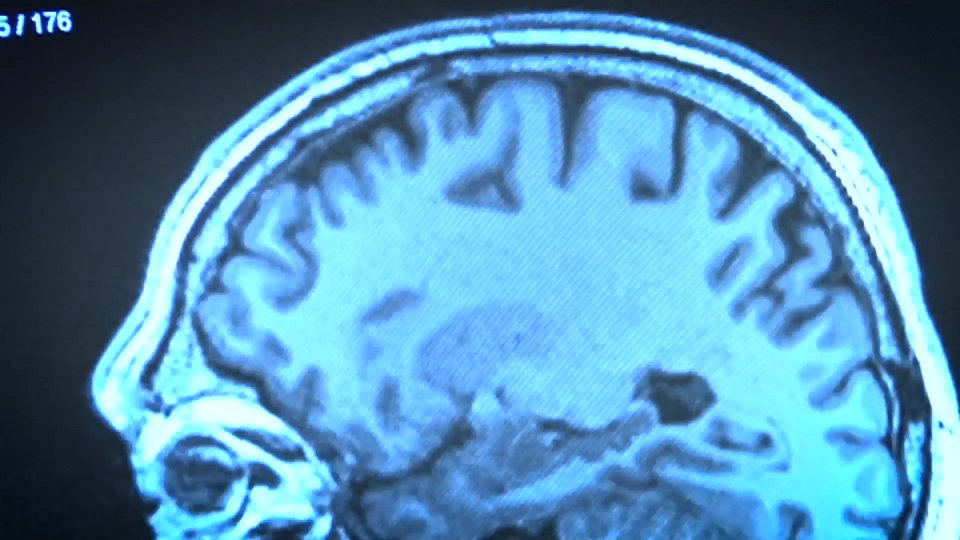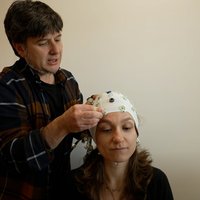[Effect of pinpilinax and thyroid gland disorders].
When studying disorders of the thyroid gland, I remember the butterfly effect proposed by Edward Norton Lorenz. According to this concept, the simplest actions can lead to significant changes in complex systems. In this way, with two identical worlds facing each other, if in one of them a butterfly shook its wings, these worlds would end up being completely different [1].
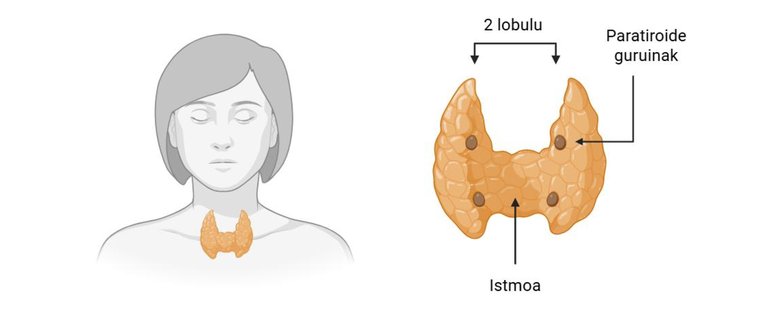
I imagine thyroid follicles as a chaotic system for the production and storage of thyroid hormones, and the smallest variant of any step in this process can have significant consequences. In relation to Lorenz’s pinpilimpauxa effect, I’ll talk to you about the thyroid gland and its disorders below.
Gland in the shape of a butterfly
The thyroid is an endocrine gland located in the front part of the neck, just in front of the trachea and under the cartilage of the same name. It is said to have the appearance of a pinpilinnuxa, as it is composed of two lobes connected by a structure called an isthmus [2].
Structurally, it is directly related to the parathyroid glands (located in the posterior face) and the retrograde laryngeal nerves—the latter involved in the innervation of the vocal cords. For this reason, among the complications of thyroid gland surgery, we can find voice disorders and those related to calcium metabolism [2].
A little bit of physiology
The structural and functional unit of the thyroid gland is the thyroid follicle. If you examine this tissue under a microscope, you will see that it consists essentially of 3 parts: follicular cells, colloid, and parafollicular cells (also called C cells). Follicular cells play a role in the synthesis and release of thyroid hormones and overlie the cavity that is filled with a substance called colloid. In contrast, C cells are responsible for the synthesis of calcitonin (a hormone associated with calcium metabolism) [2].
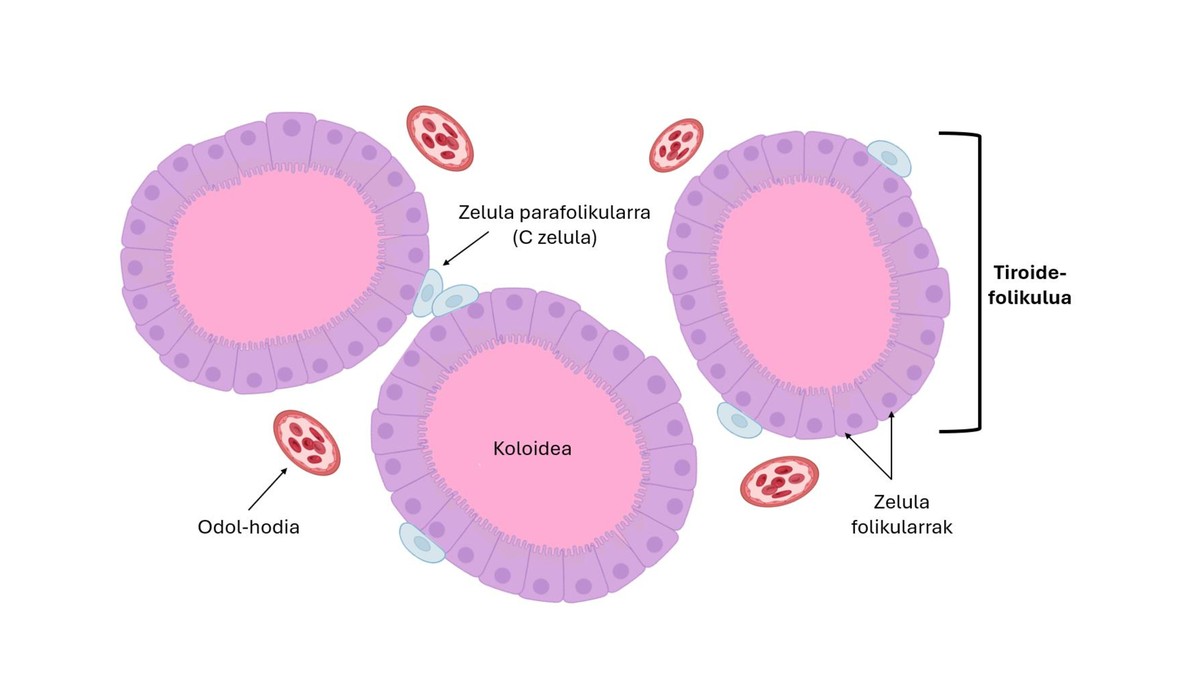
This butterfly gland is involved in the synthesis of hormones called thyroxine (T4) and triiodothyronine (T3). For this process, it is necessary for the thyroid to acquire iodine and the amino acid tyrosine. Iodine is obtained by diet and absorbed in the small intestine in its inorganic form (iodide). On the other hand, the synthesis of a protein called thyroglobulin is also essential: it is synthesized by follicular cells through tyrosine and then secreted into the colloid [2, 3].
Before I continue with the explanation of thyroid hormone synthesis, I would like to clarify some concepts in cell biology so that you can understand the process well. Epithelium is the tissue formed by one or more layers of interconnected cells that cover body cavities and vessels. In the case of the thyroid, the epithelium of this gland is formed by follicular cells. On the other hand, in all epithelial cells, two membranes protrude: the basolateral membrane, the plantar and lateral region of the cell, and the apical membrane, located at the top [4].
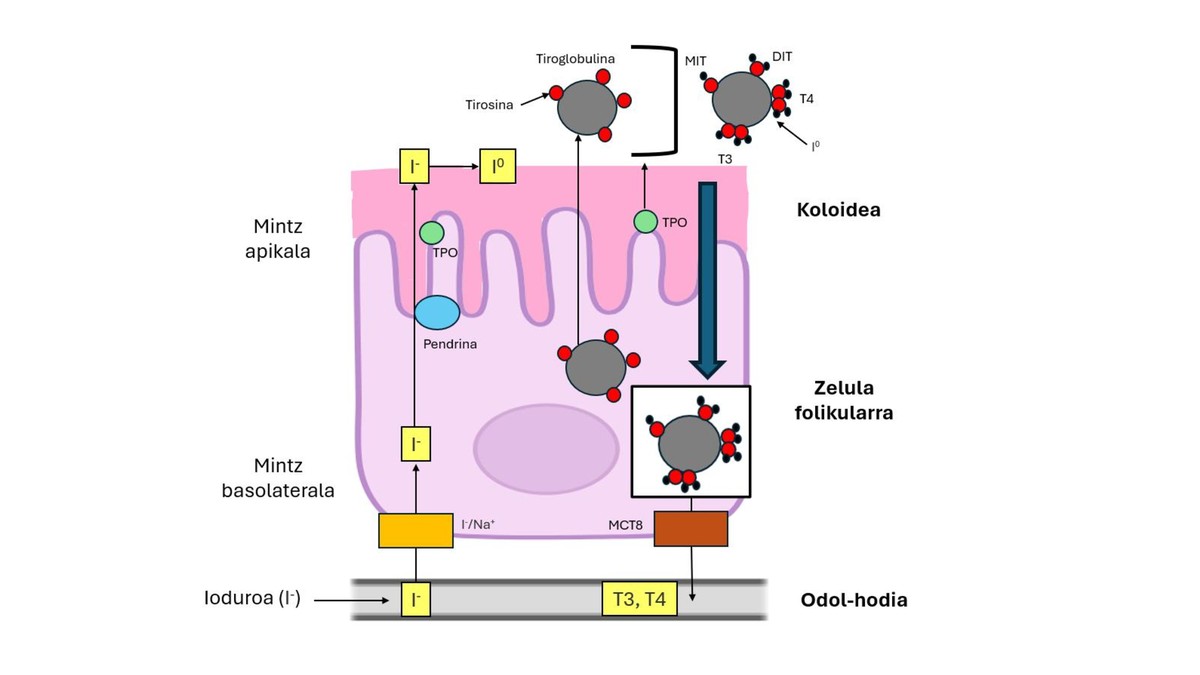
If you look at the image (see Figure 3), the side facing the colloid would be the apical membrane of the follicular cell, while the side where the blood vessel appears would be the basolateral membrane. On the contrary, I would like to point out that the purpose of the carrier proteins is to allow the transport of ions and molecules into the cell membranes to be carried out. Knowing these details, I believe that you are ready to enter into the synthesis of thyroid hormones [4].
As noted, iodine is transported in its inorganic form in the blood. Upon reaching the thyroid epithelium, it is internalized into the cell cytoplasm by a carrier protein located in the basolateral membrane of its follicular cells. This membrane transporter protein, along with iodide, allows sodium to enter the cell. Once inside the cell, the iodide is released into the apical membrane. There, thanks to a protein called pendrine, it flows into the colloid [2, 3].
In the apical membrane of the cell, iodide is oxidized to iodine (i.e., returns to its organic form) by an enzyme called thyroid peroxidase (TPO). The same peroxidase used to acquire the organic iodine is used to bind this iodine to the tyrosine of the thyroglobulin and form therefrom molecules called monoiodotyrosine (MIT) and diiodotyrosine (DIT). As the name suggests, MIT is formed by the binding of one iodine atom to a tyrosine amino acid and two iodine atoms to the tyrosine bond to DIT [2].
As you can imagine, the thyroid hormones mentioned above are formed by the association of different molecules of MIT and DIT. The T3 hormone is produced by the association of MIT and DIT, while T4 is produced by the association of two molecules of DIT. In this coupling reaction, the above-mentioned peroxidase [2] is involved.
Finally, as a response to different stimuli, thyroid hormones are secreted. In this process, by pinocytosis, thyroglobulin is reinternalized into the cytoplasm of the follicular cell. To understand what pinocytosis is, imagine invaginating the apical membrane of the follicular cell into the cytoplasm and internalizing a portion of the colloid (including its native substances) into the vesicle-like cell. The follicular cell may be said to drink and internalize a portion of the colloidal substance [2, 4].

In this way, the vesicle that has been produced intracellularly by pinocytosis is fused with lysosomes, and its enzymes (called proteases) digest tyroglobulin and release T3 and T4. Part of the iodine is released from tyrosine by a series of enzymes called dehalogenases and is reused [3].
Secretion of hormones T3 and T4 is mediated by a transporter located in the basolateral membrane of the cell (the MCT8 transporter). In the blood, these hormones are transported in association with different plasma proteins until they reach the target organs that will carry out their actions [5].
In addition, thyroid hormones can be metabolized and inactivated by more than one route, the most important of which is the deiodination process [2].
How is the process regulated?
Regulation of thyroid hormones occurs primarily through the hypothalamus-pituitary axis. TRH (thyrotropin-releasing hormone) is synthesized in the soma or nuclei of neurons in the hypothalamus located in the body. Through its axons it reaches the anterior pituitary, stimulating the synthesis and secretion of TSH (thyroid stimulating hormone) in its tyrotropic cells. The latter hormone reaches the thyroid cells through the blood, thus stimulating the production of thyroid hormones [2, 5].
The decrease in thyroid hormone concentration leads to an increase in TSH in the pituitary and TRH in the hypothalamus. In contrast, an increase in the concentration of thyroid hormones would have an adverse effect on the pituitary and hypothalamus. This process of regulation is called negative feedback [2].
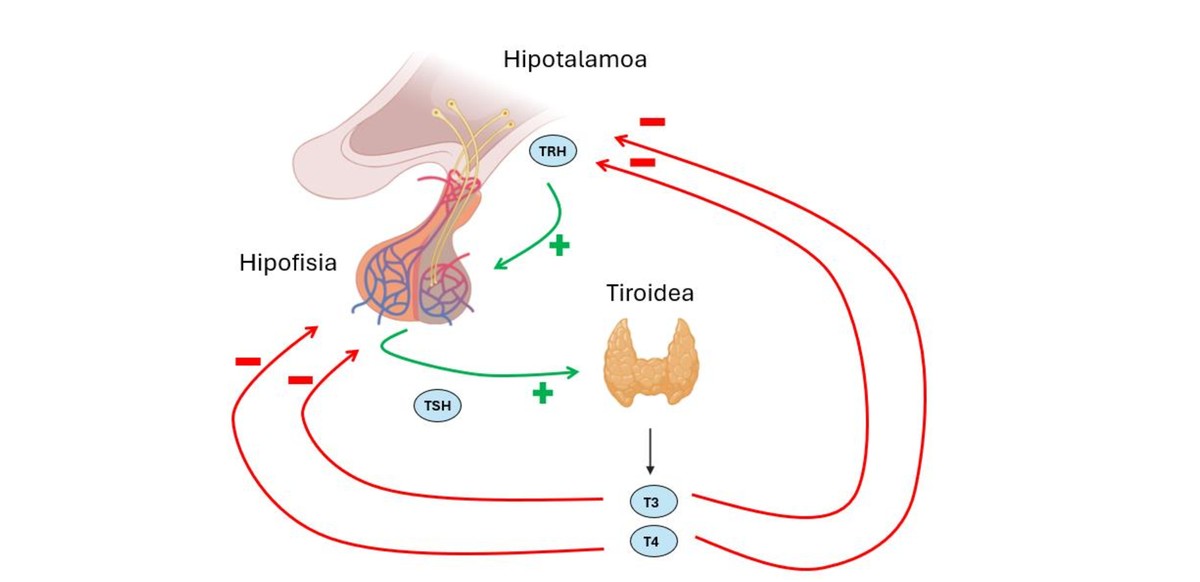
What if there's a mistake?
Although I have tried to explain the synthesis of thyroid hormones in a simple way, as you can see, it is a procedure with many steps and elements. As such, the flutter of a pinpilinnuxa can cause significant changes in this pinpilinnuxa gland.
What steps can changes affect the synthesis of thyroid hormones?
Let’s start with the first steps. For example, insufficient iodine intake in the diet, poor absorption in the small intestine, or elimination of large amounts by urine would result in insufficient precursors for the production of thyroid hormones.[2]
In contrast, the lack of proper functioning of the membrane transporter protein located on the basolateral side of the follicular cell would also have consequences for this process. Remember that this protein is required for intracellular iodide incorporation. Among other things, several mutations have been described in the SLC5A5 gene, a defect in this membrane protein that leads to congenital hypothyroidism. Several drugs can also cause changes in this transporter protein, which may not allow iodide to pass through the membrane [6].
On the other hand, as noted, there is a protein called pendrin in the apical membrane of the thyroid cell. This protein is not only found in the thyroid gland, but also in the inner ear. For this reason, it is possible that mutations in the gene encoding this protein, namely the SLC26A4 gene, could cause Pendred syndrome. This syndrome can lead to hearing loss, an enlargement of the thyroid gland (called golo or goiter in medical terms) and a disturbance of balance [7].
Errors in thyroglobulin synthesis or alterations in thyroperoxidase also affect the process of thyroid hormone synthesis. These defects may be congenital or related to both drugs and foods. For example, in Hashimoto's disease, the body produces antibodies against both thyroperoxidase and thyroglobulin, leading to hypothyroidism [2].
On the other hand, changes in the final steps within the follicular cell can also influence the process, both by defects in the fusión between the lysosome and the vesicle and by alterations in the dehalogenase [2].
To conclude, keep in mind that both possible changes in the proteins that transport thyroid hormones in the blood and alterations in the hypothalamus-pituitary axis can also influence the whole process [3].
Pinpilinpauxa and thunders
Ray Bradbury, in his 1952 account The Sound of a Thunder, described an expedition to the past to hunt dinosaurs. In it, one of the hunters accidentally steps on a poppy, which radically changes the future [8].
In line with what I was saying at the beginning, both the anatomical shape that forms the two lobes of the thyroid gland and the possible consequences of errors in the procedures that are carried out in it, make me think at all times of the pinpilinpaux.
Who would have thought that starting to reflect on the random winged movements of a butterfly, we would end up thinking about the steps your body needs to take to produce thyroid hormones?
The bibliography
[1] By Lorenz E. In the case of N. 1993. The Essence of Chaos. Organized by CRC Press.
[2] Pérez Arellano J. L. 2019. Assisted by Sisinio de Castro. [Manual of general pathology (8th edition)]. More information about Elsevier Spain.
[3] By Santiago Peña L. I'm talking about F. 2020) “Thyroid Physiology. Disfunction and laboratory tests in thyroid diseases”. According to the Rev. ORL, Salamanca, 11(3): 253-257.
[4] By Pawlina W. 2020. I'm talking about Ross. [Histology: text and atlas]. Correlation with molecular and cellular biology. Assisted by Wolters Kluwer.
[5] By Shahid M. I'm talking about A., Organized by Ashraf M. A. and Sharma S. 2023. Physiology by Thyroid Hormone. It's the StatPearls.
[6] Spitzweg C. and Morris J. C. 2011. “Genetics and Phenomics of Hypothyroidism and Goiter due to NIS Mutations”. Moll Cell Endocrinol, 322(1-2): 56-63.
[7] By Wémeau J. L. and Kopp P. 2017. “The Pendred syndrome.” Best Practice and Research Clinical Endocrinology and Metabolism, 31(2): 213-224.
[8] By Bradbury R. 1952. A Sound of Thunder. I'm talking about Cideb.
Buletina
Bidali zure helbide elektronikoa eta jaso asteroko buletina zure sarrera-ontzian




